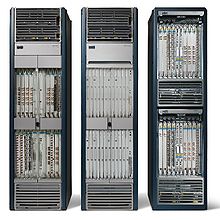- Core router
-
-
- This article is about a computer router used on the Internet backbone. For the kind used within a network, see Router. For other types see: Core router (disambiguation).
A core router is a router designed to operate in the Internet backbone, or core. To fulfill this role, a router must be able to support multiple telecommunications interfaces of the highest speed in use in the core Internet and must be able to forward IP packets at full speed on all of them. It must also support the routing protocols being used in the core. A core router is distinct from an edge router: edge routers sit at the edge of a backbone network and connect to core routers.
Contents
History
Like the term "supercomputer", the term "core router" refers to the largest and most capable routers of the then-current generation. A router that was a core router when introduced will not be a core router ten years later. At the inception of the ARPANET (the Internet's predecessor) in 1969, the fastest links were 56 kbit/s and a given routing node had at most six links. The "core router" was a dedicated minicomputer called an IMP Interface Message Processor.[1][2][3] Link speeds increased steadily, requiring progressively more powerful routers until the mid-1990s, when the typical core link speed reached 155 Mbit/s. At that time, several breakthroughs in fiber optic telecommunications (notably DWDM and EDFA) technologies combined to permit a sudden dramatic increase in core link speeds: by 2000, a core link operated at 2.5 Gbit/s and core internet companies were planning for 10 Gbit/s speeds.
The largest provider of core routers in the 1980s and 1990s was Cisco Systems, who provided core routers as part of a broad product line. This was despite the presence of faster[citation needed] and more capable[citation needed] routers from Wellfleet Communications, which existed as an independent company until it merged with SynOptics Communications in 1994, to become Bay Networks. Juniper Networks entered the business in 1996, focusing primarily on core routers. Both companies addressed the need for a radical increase in routing capability that was driven by the increased link speed. In addition, several new companies attempted to develop new core routers in the late 1990s. It was during this period that the term "core router" came into wide use. The required forwarding rate of these routers became so high that it could not be met with a single processor or a single memory, so these systems all employed some form of a distributed architecture based on an internal switching fabric.
The Internet was historically supply-limited, and core Internet providers historically struggled to expand the Internet to meet the demand. During the late 1990s, they expected a radical increase in demand, driven by the Dot-com bubble. By 2001, it became apparent that the sudden expansion in core link capacity had outstripped the actual demand for internet services in the core. The core internet providers were able to defer purchases of new core routers for a time, and most of the new companies went out of business.
As of 2007, the internet core link speed is 10 Gbit/s, with a few links at 40 Gbit/s.
Current core router manufacturers
(core router model between parenthesis)
- Brocade Communications Systems (NetIron XMR Series)
- Cisco Systems (CRS series)
- Extreme Networks (Black Diamond 20808), high-end core switch
- Huawei Technologies Ltd. (NetEngine 5000E, NetEngine 80E, NetEngine 80)
- Juniper Networks (T-series)
- ZTE (ZXR10 Series : T8000,M6000)
Previous core router manufacturers
- Axiowave Networks
- Allegro Networks
- Avici Systems (changed name to Soapstone Networks in 2008 and no longer making core routers)
- Caspian Networks
- Charlotte's Web Networks
- Foundry Networks (acquired by Brocade in 2008)
- Hyperchip
- IPOptical
- Ironbridge
- Marconi (still in business, not making core routers)
- Nortel Networks (bankrupt)
- Osphere Net Systems
- Pluris
- Procket Networks (acquired by Cisco Systems in 2004)
See also
- Cisco Systems acquisitions
References
- ^ IMP -- Interface Message Processor, LivingInternet Accessed June 22, 2007.
- ^ Looking back at the ARPANET effort, 34 years later, Dave Walden, Accessed June 22, 2007.
- ^ A Technical History of the ARPANET - A Technical Tour, THINK Protocols team, Accessed June 22, 2007.
Categories:- Internet architecture
- Routers
- Hardware routers
-
Wikimedia Foundation. 2010.

